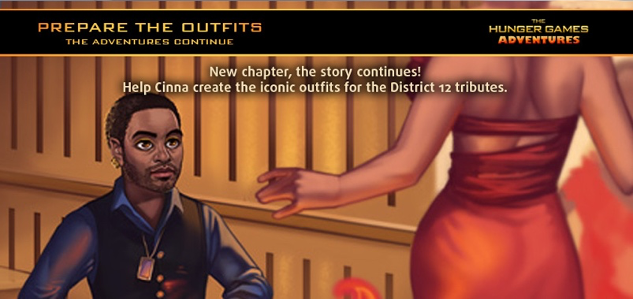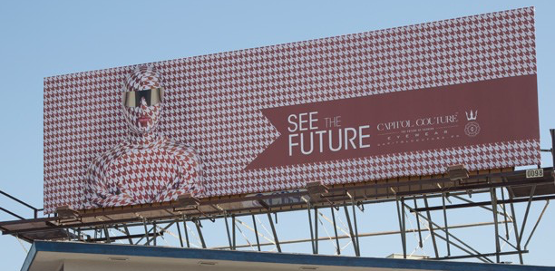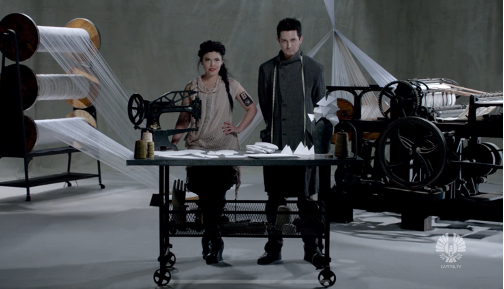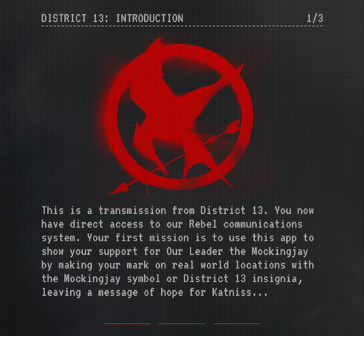
The Hunger Games: its transmedial storytelling & a fanbase full of real-life Mockingjays
As attention spans have shrunk tremendously and mindless scrolling habits have increased, content creators are trying to find new ways to tell their stories and engage their audiences. Some of them have taken their stories beyond the binding of books or confines of a screen, and instead introduced audiences to vast fictional worlds consisting of enormous amounts of content; all scattered across different media for audiences to find. This new way of storytelling is called transmedial storytelling and is introduced by American media scholar Henry Jenkins. And like Katniss Everdeen, the main character in the Hunger Games, asked Peeta Mellark the question ‘’You love me. Real or not real?’’, I will now ask you that same question, only slightly altered.
The Hunger Games narrative is one of the most clear-cut examples of transmedial storytelling. Real or not real? (Spoiler alert: yes, definitely real.)
In this paper, I will define transmediality and discuss why the Hunger Games narrative can be considered a successful transmedial project, focusing on world-building content like exhibitions and video games. Moreover, I will explain the innovative participatory websites promoting the second, third, and final movie. Finally, I will examine how the multiplatform storytelling of the Hunger Games has led to the rise of real-life Mockingjays.
What is transmediality?
To describe the immense change in the way we tell and consume stories nowadays, Henry Jenkins coined the term ‘transmedial storytelling’ in his book Convergence Culture, published in 2006. On his website Jenkins describes it as a ‘’process where integral elements of a fiction get dispersed systematically across multiple delivery channels for the purpose of creating a unified and coordinated entertainment experience’’ (2007). In his article Transmedia What? he especially emphasizes that transmedia approaches are multimodal, intertextual, and dispersed (2016). Jenkins gives a more extensive explanation in Convergence Culture:
‘’A transmedia story unfolds across multiple media platforms, with each new text making a distinctive and valuable contribution to the whole. In the ideal form of transmedia storytelling, each medium does what it does best—so that a story might be introduced in a film, expanded through television, novels, and comics; its world might be explored through game play or experienced as an amusement park attraction. Each franchise entry needs to be self-contained so you don't need to have seen the film to enjoy the game, and vice versa.’’ (2006, pp. 95-96).
Transmedial storytelling has revolutionized the way audiences interact with narratives, making them so interesting and exciting that emotional attachment to the fictional universe and its characters is almost inevitable. An important characteristic of multiplatform storytelling is its focus on setting instead of specific plots or characters, as the setting can ‘’sustain multiple interrelated characters and their stories,’’ (Jenkins, 2007), which is important for the world-building aspect of transmedia. The final characteristic of transmedial storytelling is its participatory nature, because the readers are ‘’hunters and gatherers’’, who are ‘’chasing down bits of the story across media channels,’’ and ‘’comparing notes with each other via online discussion groups’’(Jenkins, 2006, p. 21). This makes understanding a transmedial narrative inherently social as well. As information is scattered across media and each media platform opens the door to new, unique information, audiences can deepen their understanding of complex fictional worlds whenever and in whatever way they desire to.
The Hunger Games' transmediality
The Hunger Games narrative is a great example of multiplatform storytelling, as the story world consists of Suzanne Collins’ novels The Hunger Games (2008), Catching Fire (2009), and Mockingjay (2010), four movie adaptations, multiple theme park attractions, mobile games, videogames, an exhibition, and several websites and social media networks. Additionally, Hunger Games fans, also known as Tributes, can buy official merchandise, such as Mockingjay pins, crossbows, or action figures, and can also purchase a special line of CoverGirl makeup evoking the 12 Districts of Panem.
In 2017, amusement park Motiongate Dubai opened its doors to three new attractions, all part of The World of The Hunger Games. Whereas the rollercoaster Capitol Bullet Train launches Motiongate’s visitors from District 12 to the Capitol, the virtual hovercraft of the Panem Aerial Tour takes its visitors on a trip to the Capitol and hovers over each of the 12 Districts (Anstey, 2017). The queue features a Hall of Heroes, in which various District heroes are displayed. During the 3-minute tour, visitors see parts of the Capitol that have never been shown before while they listen to Effie Trinket and Boggs’, two popular book and movie characters. The World of The Hunger Games also includes a street show, café, and retail outlet (Anstey, 2017). Moreover, the immersive land resembles the setting in the movie series. At the park, fans can expand their profound comprehension of the story world, as it virtually feels like they are officially in President Snow’s territory.
The Hunger Games: The Exhibition is a touring exhibition that visited New York, San Francisco, Louisville, and Sydney. As of 2021, fans can also visit it in Las Vegas. At the interactive exhibition, dedicated fans can ‘join’ the Mockingjay in the Rebellion by following Beetee’s Archery Training, visit galleries that display District 13, the Hall of Justice, the Tribute train, or President Snow’s Office, and test their knowledge on the world of Panem with the infamous show host Caesar Flickerman (The Hunger Games Exhibition, 2021). By learning about Panem’s history and seeing the Gamemakers control table, an interactive map of Panem, and the glamorous costumes they used in the movie series, fans can discover a new side of the story and immerse themselves deeper into the world of the Hunger Games (The Hunger Games Exhibition, 2021).
Playing the Facebook game The Hunger Games Adventures also adds to the narrative’s transmediality, as users can explore the world of Panem by going on quests with Katniss and Peeta through almost all of the Districts, meet and talk to interesting citizens from various Districts, and design costumes for the Hunger Games’ Tributes with Cinna (see Figure 1) (The Hunger Games Wiki, n.d.). The game also explores multiple events that were not explained in the books or movies, such as Haymitch’s plan to use Peeta’s love for Katniss to earn sponsors in the Games. Additionally, The Hunger Games Adventures was the first place where fans could discover and see the official map of Panem.

Figure 1. Screenshot of the game The Hunger Games Adventures.
Panem’s Capitol Couture & TheCapitol.pn
To promote the first movie The Hunger Games (2012), the production company Lions Gate created a little teaser. 100 days before the movie hit the cinemas, Lions Gate hid 100 puzzle pieces on 100 different websites (Derhy Kurtz & Bourdaa, 2016). By working together via discussion groups and social media networks, loyal fans were able to piece the puzzle together, which revealed a never-before-seen poster promoting the movie. With this campaign, Lions Gate found out devoted fans love finding new information scattered across media and thus continued this strategy for the promotion of the second movie, Catching Fire (2013). The now non-existent websites promoting the movie, CapitolCouture.pn and TheCapitol.pn, and their corresponding social media accounts on Instagram, YouTube, and Tumblr, gave fans the opportunity to fully immerse themselves into the world of Panem.
At the beginning of 2013, mysterious billboards started appearing all over New York and Los Angeles (see Figure 2), promoting a new futuristic luxury fashion brand called Capitol Couture. When loyal Hunger Games fans started browsing the web, they landed at Lions Gate’s newest addition to the Hunger Games narrative: CapitolCouture.pn, which is the Capitol’s official online fashion magazine, advertised as a magazine for all ‘citizens’ of Panem. The participatory website, together with its Tumblr page and Instagram account, featured interesting insights from rich citizens and designers of the Capitol, including their fashion habits and tastes regarding makeup and interior design (Derhy Kurtz & Bourdaa, 2016). The online magazine also included a tap called Cover Stories, from which ‘citizens’ could learn more about Katniss’, Peeta’s, or Johanna’s fashion choices and their time in the Hunger Games Arenas. Additionally, citizens could ‘meet’ characters that were not prominently explored in the books and movies through ‘officially-sanctioned’ interviews. Lastly, the website featured a tap called Citizen Activity, in which ‘citizens’, Lions Gate’s positioning of fans, would appear if they sent in their own futuristic makeup or fashion looks. The website broadened fans' knowledge on the Capitol's futuristic fashion and glamorous culture, and even brought Panem to life, as it allowed fans to envision themselves as citizens of the story world.
Part of what makes the project interesting is its intermediality. According to Fluxus artist Dick Higgins, a work is intermedial when the lines between media are blurred (Higgins & Higgins, 2001). Susanne Bartsch, a Capitol-born and bred fashion designer (and of course, also a real-life designer), describes her Capitol Looks, published on Capitol Couture, as fashion that ‘’meets technology, meets the Hunger Games, and meets me.’ (Samsung US, 2015). The content on CapitolCouture.pn cannot really be described as art, technology, commercialism, or fashion alone; it falls between these media.

Figure 2. Picture of a Capitol Couture Billboard, spotted in New York.
TheCapitol.pn, which has since been removed, made immersion into the glossy world of the Capitol even easier than CapitolCouture.pn. The site allowed fans to become official citizens of Panem, as they were given a virtual ID card with a photo and an official District number (Derhy Kurtz & Bourdaa, 2016). All citizens had direct access to the Citizen Information Terminal, which featured Capitol Couture’s articles and official news from the 12 Districts and the Capitol. Additionally, a 360º view from the Capitol’s train station was featured, so that fans could discover the Capitol’s richness in the same way as Katniss and Peeta did in the first book and movie (Derhy Kurtz & Bourdaa, 2016). The website was initially created to deepen fans’ understanding of the Capitol and its glamorous culture but later turned into a propaganda site, praising the authoritarian President Snow and projecting unification, peace, and empathy. Snow’s #OnePanem initiative was established by multiple additions to the site, such as video broadcasts where Snow urged Panem’s citizens to ‘’unite and reconcile with an inviolability of the Capitol’s authority’’ (Ruban, 2021), a tap called District Heroes, and a tap called Capitol TV, which contained multiple ‘officially-sanctioned’ video series promoting the ‘good intentions’ of the Capitol.
Another video series on Capitol.pn is District Voices, which features citizens from various Districts talking about the latest developments in their Districts (Ruban, 2021). Indirectly, the videos portray Panem’s social issues, such as hunger, inequality, and poverty. At the same time, these videos put the Capitol in a good light, as the citizens use words like ‘’our generous Capitol’’ and ‘’noble Peacekeepers’’. The first signs of the Rebellion, the focus point of the third and fourth movie, can also be detected on TheCapitol.pn and Capitol TV, such as the braid Corinne wears in District 8’s District Voices video (see Figure 3). Wearing a side braid is seen as an act of defiance in the Capitol, as Katniss Everdeen, the leader of the Rebellion, always wears one. Eventually, the site was ‘hacked’ by the Rebellion and was changed to Resistance.pn. With TheCapitol.pn, fans could easily immerse themselves into the story world , as it allowed them to learn more about Panem, its Districts, its citizens, its social issues, and the start of the Rebellion. It blurred the lines between reality and fiction, as fans were positioned as real citizens of Panem.

Figure 3. Capitol TV’s District Voices – District 8’s Resourceful Style.
Revolution.pn & real-life Mockingjays
The now non-existent website Revolution.pn was TheCapitol.pn’s antagonist and was made to promote the fourth and final movie Mockingjay – Part 2 (2015). The website featured propaganda for the Rebellion and news on the 12 Districts and the Capitol, which was, unlike TheCapitol.pn’s news, uncensored (Ruban, 2021). On the website, ‘citizens’ could ‘join the Revolution’ by signing a petition and by sharing rebel propaganda on their social media with the hashtag #UNITE. Katniss Everdeen, also known as The Mockingjay, published multiple videos on the site, asking Panem’s citizens to ''fight for their well-deserved freedom'' by her side. In addition to the site, Lion Gate spray-painted thousands of Mockingjay logos all around the world for dedicated fans to find. On the app Our Leader the Mockingjay, fans could join the rebels and digitally tag the discovered logos to ‘’leave a message of hope for Katniss’’ (see Figure 4). They could find other rebels in their area, access official messages from District 13, and were updated on the evolution of the Rebellion (Derhy Kurtz & Bourdaa, 2016). With Revolution.pn and the app Our Leader the Mockingjay, fans tried to help the Mockingjay in her quest to free Panem and could thus fully immerse themselves in Katniss’ reality. And as fans were continuously positioned as ‘citizens’ of Panem, the social issues and injustices that plagued Panem almost felt like real injustices, waiting to be defeated and overcome by brave individuals like Katniss.

Figure 4. Screenshot of the app Our Leader the Mockingjay.
By visiting the websites CapitolCouture.pn, TheCapitol.pn, and Revolution.pn, fans, as ‘citizens’ of Panem, virtually experienced what it means to live in a world with dictators, poverty, and inequality. As they continuously stood with Katniss and the rebels to free the world of Panem, they started to notice what was wrong with their own world. Inspired by Katniss and her bravery, some fans became their own Mockingjays, fighting against the power imbalances of today’s world. The Hunger Games: Catching Fire – Ignite the Fight Against Hunger was one of the first ‘citizen’-created communities formed around the transmedial narrative, aimed at raising awareness about world poverty and hunger by supporting Feeding America and the World Food Program (Krikowa, 2018). Dedicated fan-activists posted a lot about the organization on their social media and asked their fellow Hunger Games fans to donate (see Figure 5). Odds in Our Favor is another community of like-minded ‘citizens’, focused on the growing economic disparity between the wealthy and the poor (Krikowa, 2018). With their campaign Join the Resistance, they hope to inform people about economic inequality. Unintentionally, the Hunger Games’ transmediality has thus caused an increase in people’s social engagement.

Figure 5. A fan’s contribution on social media to support #IgniteTheFight.
Final thoughts
As illustrated by the various examples shown above, the Hunger Games narrative can be considered a successful transmedial project. The World of The Hunger Games in Motiongate Dubai, The Hunger Games: The Exhibition, and the Facebook game The Hunger Games Adventures allowed for fans to immerse themselves deeper into the world of Panem than ever before. As each media opened the door to new information, fans could deepen their understanding of the vast, complex Hunger Games universe in a unique way.
The websites CapitolCouture.pn, TheCapitol.pn, and Revolution.pn and the app Our Leader the Mockingjay were created to promote the second, third, and final movie of the Hunger Games series and were so innovative and exciting that fans, as ‘citizens’ of Panem, almost had no choice but to deeply immerse themselves into the world of Panem. Whereas the official websites CapitolCouture.pn and TheCapitol.pn encouraged fans to immerse themselves deeper into the Capitol’s glamorous fashion and culture (and later served as propaganda sites to establish Snow’s #OnePanem initiative), Revolution.pn deepened fans’ understanding of the Mockingjay’s efforts to free Panem of its repressing demons. Finally, the multiplatform storytelling of the Hunger Games has led to the rise of real-life Mockingjays: devoted fans trying to make their own world a better place after joining Katniss and the rebels in their quest for freedom and seeing them fight so fervidly for the people of Panem. And to those, I say: may the odds be ever in your favor.
References
Derhy Kurtz, B. W. L., & Bourdaa, M. (2016). “I Am not a Tribute”: The Transmedia Strategy of The Hunger Games versus Fan Activism. In The Rise of Transtexts: Challenges and Opportunities (1st ed., pp. 90–104). Routledge.
Higgins, D., & Higgins, H. (2001). Intermedia. Leonardo, 34(1), 49–54.
Jenkins, H. (2006). Convergence Culture: Where Old and New Media Collide. New York University Press.
Jenkins, H. (2007, March 21). Transmedia Storytelling 101. Henry Jenkins.
Jenkins, H. (2016, November 15). Transmedia What? - Immerse. Medium.
Samsung US. (2015, November 20). The Hunger Games – Capitol Couture. YouTube.
The Hunger Games Wiki. (n.d.). The Hunger Games Adventures. Retrieved July 9, 2021.